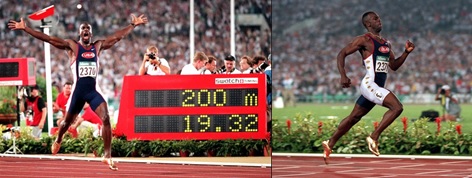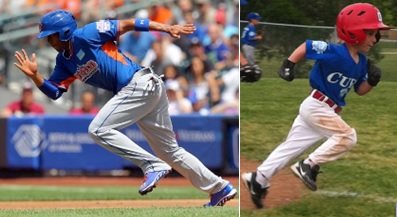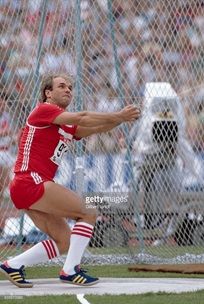“You’ll have to change your running style to be world class” -Almost every coach who recruited me except Clyde Hart. Be careful making technical changes and make sure the change is absolutely necessary. Tweet: Michael Johnson
Michael Johnson went on twitter today and said something which every coach and Speed guru should think about. The decision to change a Running Style needs careful consideration. My opinion or observation is that more experienced coaches tend to move more slowly and carefully when making a decision on why , when and how to alter or tweak a running style.
Below is the tweet and the quote “make sure the change is absolutely necessary” resonates.
“You’ll have to change your running style to be world class” -Almost every coach who recruited me except Clyde Hart. Be careful making technical changes and make sure the change is absolutely necessary.
If you want to know a bit more about Johnson below is a link to You Tube and Wikipedia.
Michael Johnson Breaks 200m & 400m Olympic Records – Atlanta 1996 Olympics

Clyde Hart Was Johnson’s coach and a link to Wikipedia is worth a look.
Clyde Hart: Michael Johnson’s Coach
TECHNICAL MODELS OF SPRINTING
I have attached a powerpoint from Dan Pfaff where he addresses the question of technical models and also whether a new model exists? I have borrowed 2 pictures from this presentation to make a point.
IS THERE A NEW MODEL OF SPRINTING?

2 examples from the same sport. Looks okay at first glance! So would we tell the little fella to lean more. Nope! Why? because as he gets stronger over time he simple will re-adjust technique and acceleration phases. In fact if we tell him to lean more it will wreck his acceleration profile. So unless there is some glaring fault in the lads technique that a coach is 99.99% sure will lead to improved performance in an LTAD perspective, not just short term then might be worth just setting up quality sessions.
FRONTSIDE MECHANICS
There is lots of research going on now about mechanics and lots of opinions. One of the researchers here has trained World Champion athletes and a sacred cow is challenged.

I will still video someone and look at whether they are overly rearside or fronstide and what their acceleration phase looks like going into maximum speed to assess whether any changes are needed.
HIGH KNEES
Justin Gatlin though does question an over emphasis on high knees in coaching young athletes.
Justin Gatlin Reveals the No. 1 Sprinting Mistake Slowing Down Young Athletes
RESEARCH
There is an enormous amount of research going on right now by people such as Peter Weyand from SMU and JB Morin and so many others in the area of acceleration, maximum speed , technique and biomechanics.
BIOMECHANICS not POSITIONS!
But the words of Prof. Anatoly Bondarchuk ring in my ears. I asked him if the foot contact of Yuri Sedych (still holds World Record in Hammer!) was at X degrees on ground contact, because I had spent years copying his technique. Bondarchuk looked at me and said ” Loris! , use biomechanics not sedykh position. You are Loris. Different. Use biomechanics, not positions. Do not copy Yuri.” Below is the position I tried to copy for 3 years wasting my time! So the subtle point is there does exist optimal biomechanics for every individual but looks different for every individual.

CAMERON LING
So I wanted to put one practical example from the AFL that I encountered. Cameron Ling was drafted in 1999 as a forward. He had very rapid turnover and a very small stride length. He also had limited ROM when screened. Cameron also had very small glutes! Not much hip extensor stuff happening. Plus his power in general was a bit down. We analyzed hs technique using Mark Sayers who is a Sports Scientist. Looked ok. So simply we spent a year working on physical changes . Glute and hamstring strength, range of motion both statically and dynamically, leg power, sled running, horizontal bounding and so on. There was a marked change in his technique and after a year he improved .25 in his 20 metres speed test and acceleration profile. Because he had a MAX VO2 of 69 ml/kg/min at 90 plus kgs he was able to repeat his speed all day. Rest is history. Great player.

COACHING CUES
Coaching Cues | Science for Sport
Even with young athletes, tread carefully and might be a good idea to read Nick Winkleman’s excellent wealth of information on how to cue speed before telling kids they are doing it all wrong. Below is a link to one of these articles.
I have put a few comments on TWITTER stimulated by the Michael Johnson tweet and really they ask quite a few questions from Elite to Beginner and why, when and how we should change running styles.
Stuart McMillan @StuartMcMillan1
Very important question to attempt to answer BEFORE we try to affect mechanics. IMO – inputting a technical change that leads to a detriment in performance is a dangerous game. I’d rather apply small ‘tweaks’, and monitor closely as we go
Before that, how do we know, with any degree of certainty, whether a particular technical change will: 1) lead to improved performance; and, if so, 2) is reliable/robust under pressure? Biomechanists/biomechanical analyses should help answer these questions but do they/can they?
Replying to @StuartMcMillan1
Agreed. A heuristic/trial and error approach, monitoring performance outcomes following intervention, is the way to go. Commensurate with active exploration/guided discovery, which can lead to robust, albeit not necessarily orthodox-looking, movement solutions.
Replying to @StuartMcMillan1
Absolutely correct, Stuart! Within the “Athlete Factory”, HP coaches & development coaches occupy different stations on the conveyor belt. Early stations => MAJOR tweeks Late stations => MINOR tweeks This is the ideal, right?
Replying to @PaulGlazier
Not only biomechanics, in addition, all realms of psychomotor and sensorimotor discovery due to the orders of magnitude faster computational processing speed of the brain in comparison to volitional motor functions. The knowledge will stem from theory driven experimentation.
I agree with your sentiment but that could be some gamble with an already high-performing athletes whose livelihood depends on their performance! There are lots of examples of major-winning golfers who have tried to “improve” only to fade into obscurity.
Victor Hall @TeamEXOS #AthletigenACP
“When making technical changes we may see a decrease in speed before the net gain begins to emerge – it is important to trust the process.” –